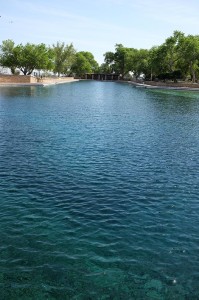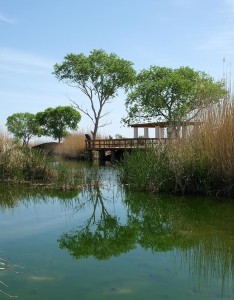Look up, and it’s surrounded by a cement patio with depth markings on the sides, a diving board and a cabana.
It’s not an uncommon sight at large natural springs like this that long ago became a “resort” of sorts. Once a watering hole and source of irrigation, San Solomon Springs was turned into a big swimming pool by the Civilian Conservation Corps in the aftermath of the Depression.Today, known as Balmorhea State Park, it’s a big draw for both sun bathers and divers, who enjoy the apparent juxtaposition of desert and tropics, as one observer describes:
Balmorhea State Park is small at just 45.9 acres, but its enormous pool spans 1.75 acres, holds 3.5 million gallons and is 25 feet down at its deepest point. The prolific springs that fill the pool put out more than 22 million gallons of water daily at a balmy 72 to 76 degrees.Hundreds of small shiny fish no more than two inches long swirled around the scuba diver… Along the smooth-pebbled bottom, a turtle the size of a Thanksgiving turkey platter cruised in slow motion… A juvenile catfish swam up to her outstretched finger and nibbled inquisitively but harmlessly with its baby teeth. The diver laughed out loud, nearly spitting out the mouthpiece that supplied her air 20 feet underwater. Why did she laugh? Because she was diving – not off some sunny Caribbean island – but in the desert of West Texas.
Beyond the recreational pool, the park has made an effort to “naturalize” some of its surroundings. Reedy canals from the pool now connect to a small patch of nascent desert wetlands, known as the Cienega Project, a wet, grassy haven for wading birds, fish and wildlife.
The Cienega and its canals are home to the sole remaining population of two small endangered desert fishes: the Pecos Gambusia and Comanche Springs Pupfish. Both are less than two inches long but they are thriving by the thousands in the park’s canals and wetlands. The pupfish were once more widely distributed, but their other habitats have steadily dried up over the years.


